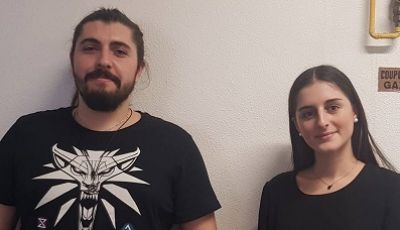Equipes de recherche
Plateforme NeuroTimone (PFNT)
La PFNT (Plateforme NeuroTimone) est un ensemble cohérent d'outils d'exploration en neurobiologie permettant des investigations aux échelles moléculaires, cellulaires et intégrées.
A la Une
-
 Semaine du Cerveau : Causerie de Michel Khrestchatisky (INP) sur le Campus de la Timone
Semaine du Cerveau : Causerie de Michel Khrestchatisky (INP) sur le Campus de la TimoneEn raison des mesures prises pour freiner l'épidémie COVID-19, cette causerie est bien évidemment annulée ...
-
 The GlioME team published a new article in Oncotarget journal: EB1-dependent long survival of glioblastoma-grafted mice with the oral tubulin-binder BAL101553 is associated with inhibition of tumor angiogenesis.
The GlioME team published a new article in Oncotarget journal: EB1-dependent long survival of glioblastoma-grafted mice with the oral tubulin-binder BAL101553 is associated with inhibition of tumor angiogenesis.Our study shows that a treatment with the microtubule-destabilizing agent BAL101553 counteracts tumor angiogenesis by acting on glioblastoma stem-like cells, in an EB1-dependent manner. This work provides new insights into the therapeutic targeting of cancer stem-like cells.
-
 CNRS - Amélioration de la Qualité de Vie au Travail
CNRS - Amélioration de la Qualité de Vie au TravailAu printemps 2019, le CNRS a lancé un appel à projets, pour la 3e année consécutive, dans l’optique de l’amélioration de la Qualité de Vie au Travail (QVT)...
-
 Philipp Tsvetkov received a 29 000 € grant from the GEFLUC
Philipp Tsvetkov received a 29 000 € grant from the GEFLUC- The Emergence project entitled “New high throughput screening method for anticancer agents” carried out by Philipp Tsvetkov (first from the right) was selected by the Canceropole PACA to be funded by the GEFLUC (groupement des entreprises françaises dans la lutte contre le cancer).
-
 Aurélie Tchoghandjian, jeune chercheur dans l'équipe GlioME a brillament obtenu son Habilitation à Diriger les Recherches (HDR)
Aurélie Tchoghandjian, jeune chercheur dans l'équipe GlioME a brillament obtenu son Habilitation à Diriger les Recherches (HDR)Aurélie Tchoghandjian a soutenu son Habilitation à Diriger les Recherches (HDR) devant un jury d'experts composé de cliniciens : Pr. Nicolas André, Pr. François Ducray, Pr. Dominique Figarella-Branger; et de chercheurs : Dr. Emmanuelle Huillard et Dr. Monique Dontenwill.
-
 New publication from Sylvie Carmona (Neuro-inflammation and Multiple Sclerosis team - INP team 5)
New publication from Sylvie Carmona (Neuro-inflammation and Multiple Sclerosis team - INP team 5)As part of her PhD, Sylvie Carmona investigated the beneficial effects of NV669, an aminosterol derived from squalamine on human pancreatic and hepatic cancer models. In vitro results exposed in this paper showed that NV669 inhibited the proliferation of cancer cells, induced cell cycle arrest and subsequent apoptosis. Moreover, NV669 inhibited PTP1B activity and impacted adhesion molecules expression. This suggests that NV669 by inhibiting PTP1B would affect cell contacts and would induce apoptosis.
-
 L'équipe NeuroCyto dans La Provence
L'équipe NeuroCyto dans La ProvenceLes travaux récents de l'équipe NeuroCyto pour dévoiler l'architecture des des axones font l'objet d'un article dans l'édition du vendredi 17 Janvier de La Provence.
Voir l'article de La Provence dans son intégralité ici ou ci-dessous.
Plus d'information dans l'article scientifique publié recemment dans la revue Nature Communications :
-
 Deux nouveaux arrivants dans l'équipe GlioME
Deux nouveaux arrivants dans l'équipe GlioMEL'équipe 8 (GlioME) a le plaisir d'accueillir deux étudiants en Master 2, Anaïs Arathni étudiante en Master Biologie Santé et Emmanuel Snacel-Fazy étudiant en Master Neurosciences. Anaïs travaillera avec Aurélie Tchoghandjian sur la caractérisation des cellules immunitaires recrutées sur le site tumoral suite au traitement par mimétiques de Smac. Emmanuel travaillera avec Chiara Bastiancich sur le microenvironnement de la résection tumorale du glioblastome.
Pages
L'INP en chiffres
- 126 membres
- 44 chercheurs
- 48 chercheurs assistants
- 12 post-doctorants
- 11 doctorants
2 INP researchers in La Marseillaise "Provence Terre de Science"
Each week-end the local newspaper La Marseillaise puts the spotligh on a scientific topic and on a team of research in a scientific page called "Provence Terre de Science". After the page about Alzheimer disease last year (see here), INP research has been highligthed with the interview of Jean Marc Sabatier (Cytoskeleton and Neurophysiopathology team) for his work on venoms, and then Christophe Letterier (NeuroCyto team) for his work on sup
Le jury d'Hybrid Art du centre d'art Fernand Léger a retenu le dossier de Nadia Coliac pour l' édition 2021
Pour Hybrid’Art 2021, l’artiste-chercheure observe la bioluminescence exposée à l’air libre, à la température ambiante pour analyser l’impact de l’oxygène sur la durée de vie des bactéries d’origine marine, en dehors des conditions stériles habituelles. C’est une rencontre poétique et émotionnelle, dans l’intimité de ces « êtres de lumière » où l’homme est à la fois acteur et spectateur face à cette lumière qui interpelle sur notre manière de consommer et de consumer et la vie et la lumière.
INP first video abstract ?
A couple weeks after the release of article "An AI-Powered Blood Test to Detect Cancer Using NanoDSF" authored by Tsvetkov Philipp*, Eyraud Rémi*, Ayache Stéphane, Bougaev Anton, Malesinski Soazig, Benazha Hamed, Gorokhova Svetlana, Buffat Christophe, Dehais Caroline, Sanson Marc, Bielle Franck, Figarella Branger Dominique, Chinot Olivier, Tabouret Emeline* and Devred François* in Cancers, the two first and two last authors of this interdisciplinary study participated in their first video abstract.
FRM Équipe 2021 to the NeuroCyto team
The NeuroCyto team was awarded an “Équipe” grant from the Fondation pour la Recherche Médicale. With more than 400,000 euros over three years, it will allow the team to investigate the organization and role of actin at presynapses using advanced micromanipulation and cutting edge super-resolution microscopy.
















































